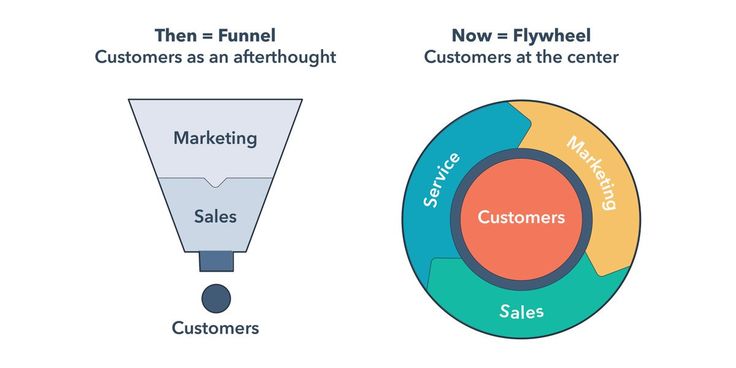- By Camila Ante

Unlike the marketing funnel, the customer-based cycle - Flywheel - has the ability to accumulate and release energy, and this is very important when designing a business strategy.
James Watt created this wheel-shaped model to represent energy efficiency. Like the wheels of a train or a car, the amount of energy it stores depends on the speed with which it rotates, the friction or interference it encounters, and the size.
This energy is especially helpful when considering how customers can drive your business growth.
With the customer-based cycle -Flywheel-, we harness the momentum of a satisfied customer to drive referrals and repeat sales. Basically, your business goes round and round.
This is not a marketing maneuver, nor are we talking technical language, and we are definitely not redefining the same process.
When you perceive your company as a cycle and not as a funnel, the decisions you make are different and you modify your strategy. To illustrate this concept, we will first explain how this wheel works.
How does it work?
As we mentioned before, the amount of energy or momentum that the customer-based cycle wheel contains depends on three aspects:
- How fast you spin it
- The amount of friction or interference that exists
- The size
The most successful companies adapt their business strategies to address these three factors. Wheel speed increases when you apply force to the areas that have the most impact, such as the customer service team. By focusing on how you can help your clients succeed, you are more likely to pass on their achievements to other potential clients.
Remember that every company is different, and how you design your customer-based cycle depends on your business model. Find out which teams and areas in your company have the greatest impact on growth. Customize your customer-based cycle around that information and strengthen those areas.
As you will apply force to the cycle wheel, you will also need to make sure that nothing is in the way; that is, you must eliminate interference from your business strategy. To do this, you can analyze how the teams are constituted in your company, why customers are lost and in what part of the buyer's journey prospects get stuck. Are all of your teams aligned or does each one operate in isolation? Are your prices clear or plagued with confusing charges? Do you allow prospects to connect with your company when, where and how they want, or are they required to follow rigorous processes?
The higher speed and lower friction, the more promoters you will have for your business, and it is these who will grow the customer-based wheel.
Companies that decide to use the customer-based cycle model instead of the traditional funnel have a huge advantage, as they are not the only ones helping their businesses grow, but their customers are also helping them grow.
The inbound methodology and the customer-based cycle
The client-based cycle - Flywheel - also helps eliminate interference and reduce problems in transfers between computers. In the funnel model, customers often go from marketing to sales, and from sales to customer service. This can create an unpleasant experience for them. With the customer-based cycle model, each team in the business has a responsibility to attract, engage, and delight customers. When all your teams are aligned around the inbound methodology, you can provide a more comprehensive and pleasant experience to those who interact with your company.
Why switch to the customer-based cycle
The actions that each team takes in a company affect the other teams. Your marketing data affects the speed with which prospects go through the sales process; your sales processes affect the likelihood of prospects turning into successful, satisfied customers; And, of course, your technical assistance and customer service activities influence the possibility of your clients becoming promoters; that is, people who recommend your company to other colleagues or warn them about it.
Currently, 57% of B2B purchasing processes are completed before buyers interact with suppliers; And buyers don't pay attention to your company's marketing materials to make a decision: product reviews on third-party sites, recommendations play an important role in making purchasing decisions like never before.
Meanwhile, trust in companies is plummeting: 81% of buyers trust the recommendations of their families and friends more than business advice, and 55% report that they trust companies less than before. they used to buy.
Conversations take place on more channels and between more people. The marketing funnel was a prime example of the way buyers used to find out about certain products: they found or received marketing material, they had to talk to sales reps for more information, and only then did they become customers.
However, today buyers make decisions differently. They ask their contact networks for advice, look for mentions of your company on social networks and be sure that they read opinions of your products or services on third-party sites.
The traditional funnel model doesn't take these factors into account, and because they're linear, funnels don't reveal the expectations that a great product or exceptional customer experience creates, or the roadblocks you face when your processes start to slow growth.
The customer-based cycle model brings all of these factors together. By eliminating interference from your internal processes, you can spin the wheel and grow faster. The most relevant thing is that when you combine it with the inbound methodology, the wheel model reveals the importance of the customer experience.
The delight stage enhances the attraction stage of the inbound methodology because it is clear that the way you treat your customers affects the opinions that prospects hear about your company.
The customer-driven cycle provides a more complete picture of where your business is growing the most, and reveals the best opportunities.
If you want to learn more about this funnel, click here and reserve your space for a personalized workshop.
Article: Hubspot.